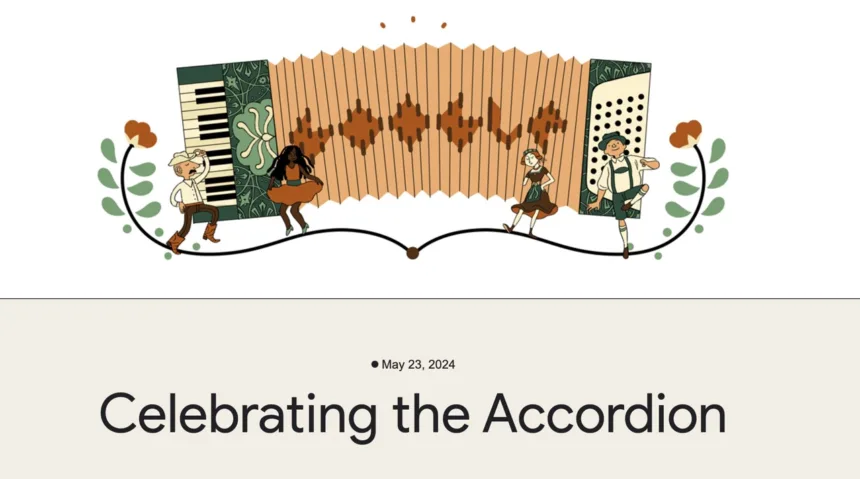Today on 23rd May 2024 (Thursday), Google Doodle paid tribute to the Accordion, a cherished German musical instrument, celebrating its rich history and enduring influence on various music genres. The doodle marked the anniversary of the accordion’s patent, granted on this day in 1829.
The Origins and Evolution of the Accordion
A Brief History
The accordion, a free-reed instrument with bellows, was patented in 1829 by Cyrill Demian, an Armenian-Austrian inventor based in Vienna. Demian’s design revolutionized music with its portability and distinctive sound, making it a favorite among traveling musicians.
More Read
The Name and Its Meaning
The term “accordion” comes from the German word “akkord,” meaning chord, emphasizing the instrument’s ability to produce rich, harmonic sounds. This nomenclature reflects the accordion’s role in creating complex musical textures.
The Accordion’s Role in Various Music Genres
Folk Music
The accordion quickly became a cornerstone of folk music across Europe. Its robust sound and ease of transport made it ideal for outdoor gatherings and social events. It remains a symbol of cultural identity in many regions.
Classical and Jazz
In the classical realm, composers like Igor Stravinsky and Astor Piazzolla incorporated the accordion into their works, appreciating its unique tonal qualities. In jazz, the accordion adds a distinctive voice, blending seamlessly with traditional jazz instruments to create a rich, layered sound.
The accordion is more than an instrument; it’s a bridge between cultures, a storyteller of traditions, and the heartbeat of folk music.
Pop Music
Pop artists have also embraced the accordion, using its lively sound to add a unique flavor to their music. Its versatility allows it to complement a wide range of musical styles, from upbeat dance tracks to mellow ballads.
The Accordion’s Mechanism and Variants
How It Works
The accordion produces sound through the movement of air over free reeds, which vibrate to create musical notes. The bellows, controlled by the player, regulate the airflow, allowing for dynamic expression.
Variants of the Accordion
Several variants of the accordion emerged during its development in the early 1800s. Notable types include:
- Concertina: Smaller and more compact, often hexagonal, popular in traditional Irish and English music.
- Bandoneon: Integral to Argentine tango, known for its rich, melancholic sound.
- Harmonium: A larger, keyboard-based instrument used in classical and religious music.
The Accordion Today
Cultural Significance
Today, the accordion continues to be celebrated for its cultural significance and versatility. It is an essential instrument in genres ranging from Cajun and Zydeco in the United States to Musette in France and Tejano in Mexico.
Modern Innovations
Modern advancements have led to the creation of digital accordions, which replicate traditional sounds while offering a broader range of musical possibilities. These innovations ensure the accordion remains relevant in contemporary music.
Google Doodle’s Tribute
Google Doodle’s celebration of the accordion underscores its historical importance and ongoing impact. By spotlighting this instrument, Google honors not only its invention but also the countless musicians who have made the accordion their “main squeeze,” enriching the world with its vibrant and evocative sound.












